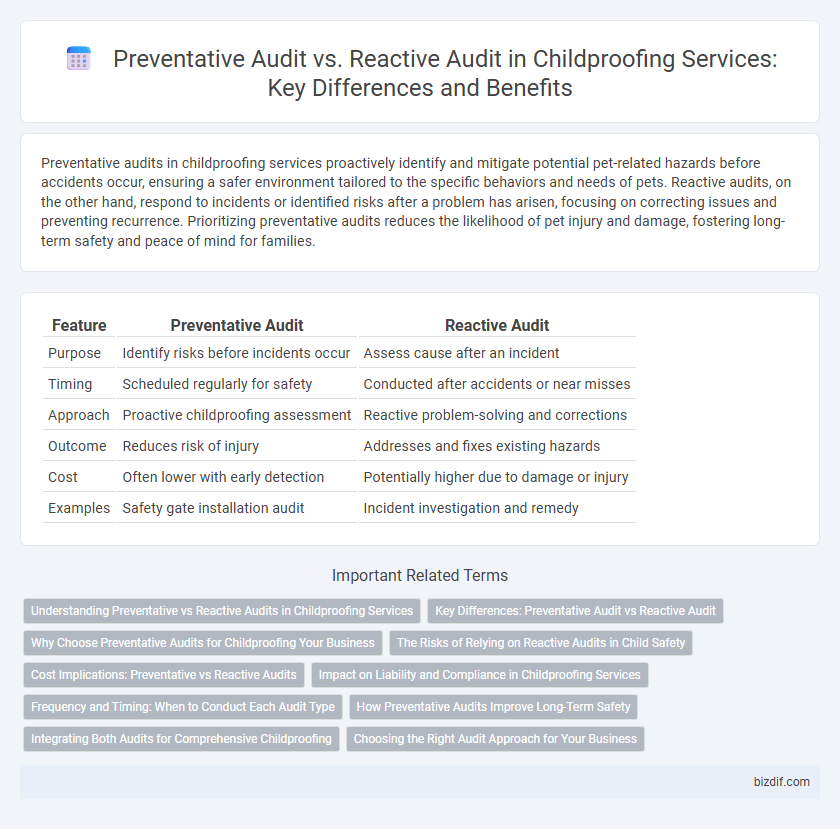Preventative audits in childproofing services proactively identify and mitigate potential pet-related hazards before accidents occur, ensuring a safer environment tailored to the specific behaviors and needs of pets. Reactive audits, on the other hand, respond to incidents or identified risks after a problem has arisen, focusing on correcting issues and preventing recurrence. Prioritizing preventative audits reduces the likelihood of pet injury and damage, fostering long-term safety and peace of mind for families.
Table of Comparison
| Feature | Preventative Audit | Reactive Audit |
|---|---|---|
| Purpose | Identify risks before incidents occur | Assess cause after an incident |
| Timing | Scheduled regularly for safety | Conducted after accidents or near misses |
| Approach | Proactive childproofing assessment | Reactive problem-solving and corrections |
| Outcome | Reduces risk of injury | Addresses and fixes existing hazards |
| Cost | Often lower with early detection | Potentially higher due to damage or injury |
| Examples | Safety gate installation audit | Incident investigation and remedy |
Understanding Preventative vs Reactive Audits in Childproofing Services
Preventative audits in childproofing services involve proactive inspections to identify and mitigate potential hazards before accidents occur, ensuring a safe environment for children. Reactive audits are performed after an incident or safety concern has arisen, aiming to address specific issues and prevent future occurrences. Understanding the difference enhances effective safety management by prioritizing prevention rather than solely responding to problems.
Key Differences: Preventative Audit vs Reactive Audit
Preventative audits in childproofing services proactively identify potential hazards before incidents occur, ensuring a safer environment for children by addressing risks early. Reactive audits are conducted after an incident to determine causes and implement corrective measures, focusing on resolving specific safety failures. Key differences include timing--preventative audits are scheduled regularly, while reactive audits respond to events--and objective, with prevention versus incident response shaping audit focus.
Why Choose Preventative Audits for Childproofing Your Business
Preventative audits identify potential safety hazards before incidents occur, reducing liability risks and fostering a safer environment for children in your business. These proactive assessments ensure compliance with child safety regulations, minimizing costly repairs and legal implications associated with reactive audits. Prioritizing preventative childproofing audits enhances your business reputation by demonstrating a commitment to child safety and proactive risk management.
The Risks of Relying on Reactive Audits in Child Safety
Relying on reactive audits in child safety increases the likelihood of overlooking latent hazards that may cause injury before detection. Preventative audits systematically identify and mitigate risks before incidents occur, significantly reducing potential harm. Reactive audits often result in costly emergency interventions and compromised child well-being due to delayed hazard identification.
Cost Implications: Preventative vs Reactive Audits
Preventative audits in childproofing significantly reduce long-term costs by identifying hazards before incidents occur, minimizing potential injury expenses and liability claims. Reactive audits, conducted after an accident, often incur higher costs due to emergency repairs, medical bills, and possible legal fees. Investing in preventative audits ensures a safer environment and cost-effective management of child safety risks.
Impact on Liability and Compliance in Childproofing Services
Preventative audits in childproofing services significantly reduce liability by identifying and addressing hazards before incidents occur, ensuring compliance with safety standards and regulations. Reactive audits, conducted after an incident, often result in higher liability risks due to delayed hazard detection and potential non-compliance penalties. Implementing regular preventative audits enhances overall safety, minimizes legal exposure, and maintains adherence to childproofing compliance requirements.
Frequency and Timing: When to Conduct Each Audit Type
Preventative audits should be conducted regularly, typically every 3 to 6 months, to identify potential hazards before incidents occur in childproofing environments. Reactive audits take place immediately after an incident or safety concern to address specific issues and prevent recurrence. Scheduling preventative audits during routine maintenance ensures ongoing safety, while reactive audits are timely responses triggered by events.
How Preventative Audits Improve Long-Term Safety
Preventative audits in childproofing comprehensively identify potential hazards before accidents occur, reducing risks associated with unsafe environments. By systematically assessing homes and businesses, these audits enable proactive modifications that enhance long-term safety for children. Regular preventative inspections outperform reactive audits by minimizing emergency interventions and fostering sustained child safety compliance.
Integrating Both Audits for Comprehensive Childproofing
Integrating preventative and reactive audits ensures a comprehensive childproofing strategy by addressing potential hazards before incidents occur and analyzing past incidents for continuous improvement. Preventative audits systematically identify and mitigate risks, while reactive audits evaluate previous safety breaches to enhance protective measures. Combining both audits creates a dynamic safety protocol that adapts to evolving child safety standards and environments.
Choosing the Right Audit Approach for Your Business
Choosing the right audit approach for your childproofing service business hinges on whether you prioritize risk prevention or issue resolution. A preventative audit systematically identifies potential hazards before incidents occur, reducing liability and enhancing safety for clients. In contrast, a reactive audit investigates problems after they arise, often leading to higher costs and damage control efforts.
Preventative audit vs Reactive audit Infographic

 bizdif.com
bizdif.com